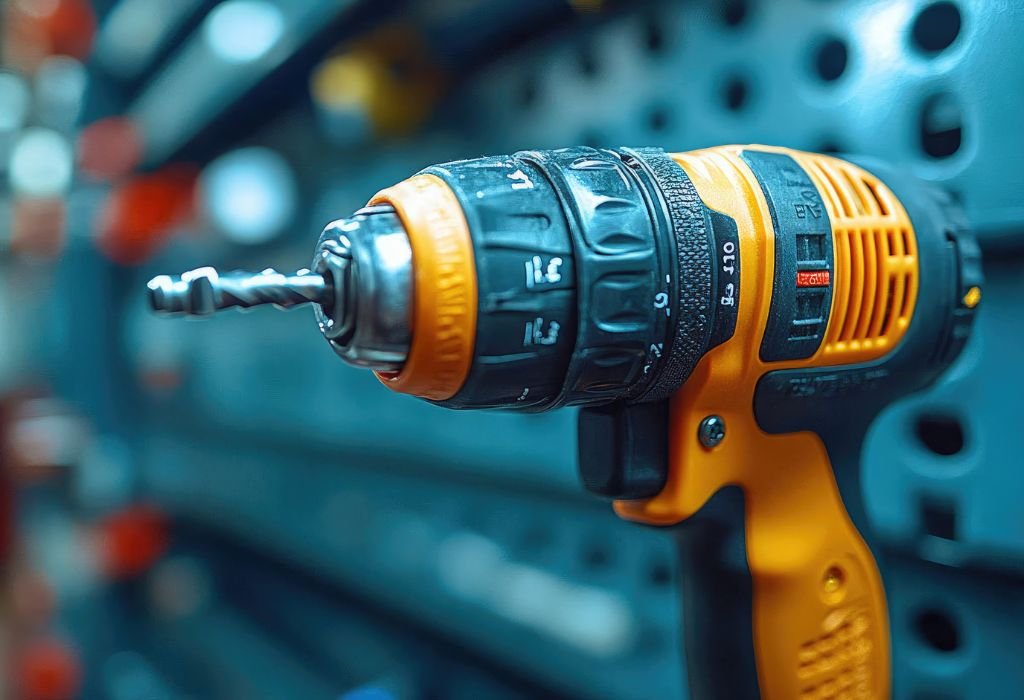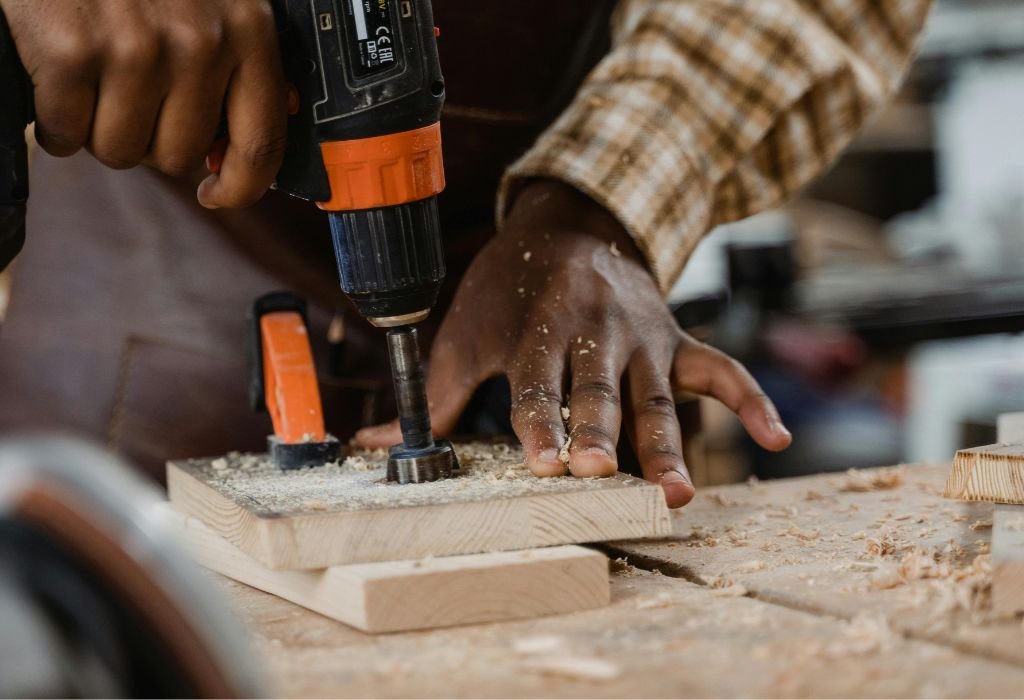Pick up a stubborn screw, try to drive it into hardwood with a regular drill, and you’ll quickly feel the struggle.
This is the exact problem that the impact driver was invented to solve—more torque, less effort, and fewer stripped screws.
Industry surveys show that over 65% of professional contractors now carry an impact driver as their primary fastening tool.
Another study revealed that using an impact driver can reduce screw-driving time by up to 40% compared to a drill driver.
Despite its growing popularity, many DIYers still wonder what an impact driver really is and how it differs from drills or hammer drills.
The truth is, an impact driver is not just a drill—it’s a specialized power tool designed to make driving screws and bolts faster, easier, and more efficient.
In this guide, you’ll learn exactly what an impact driver is, how it works, what it’s used for, its history, and why it has become an essential tool for both beginners and professionals.
What Is an Impact Driver? (Definition & Basics)

An impact driver is a power tool designed specifically for driving screws and bolts with high torque. Unlike a standard drill driver, it uses rotational force combined with concussive impacts to drive fasteners more efficiently.
Instead of a traditional chuck, an impact driver uses a ¼-inch hex collet. This design accepts hex-shank bits that can withstand the high torque output.
Most modern impact drivers are cordless, powered by rechargeable lithium-ion batteries. Corded versions exist but are far less common in everyday use.
Brushless impact drivers are becoming increasingly popular. They use advanced motors that generate less heat, last longer, and deliver more efficient power compared to brushed models.
Unlike a drill driver, an impact driver does not have an adjustable clutch. Instead, it automatically adjusts torque through its hammer-and-anvil mechanism, making it easier to drive screws without stripping them.
This simplicity, combined with raw torque, makes the impact driver an essential tool for heavy-duty fastening. It has become a favorite among carpenters, contractors, and DIY enthusiasts alike.
How Does an Impact Driver Work? (Mechanics Explained)
At its core, an impact driver works by combining continuous rotation with sudden bursts of torque. This action allows it to drive screws deeper and faster than a standard drill driver.
The motor spins a hammer-and-anvil mechanism inside the tool. As resistance builds, the hammer slips, then strikes the anvil, delivering concussive impacts.
These short, powerful bursts are measured in impacts per minute (IPM). Together with rotations per minute (RPM), they create the high torque needed for tough fastening jobs.
The variable speed trigger lets you control how fast the bit spins. Light pressure gives slow, precise starts, while full pressure delivers maximum speed and impact force.
Unlike a drill driver, the impact driver doesn’t use a clutch. Instead, the hammer-and-anvil system automatically applies only as much torque as the screw requires.
This prevents cam-out, where screwdriver bits slip and strip screw heads. It also reduces strain on the user’s wrist, since the tool absorbs much of the resistance.
Cordless impact drivers are powered by lithium-ion batteries, typically rated 12V, 18V, or 20V. Higher voltages deliver more torque, making them better suited for professional use.
Overall, an impact driver works smarter, not harder—delivering torque exactly when and where it’s needed. This efficiency is why it has become a go-to tool for fastening tasks.
What Is an Impact Driver Used For? (Applications)
Impact drivers are primarily used for driving long screws and heavy fasteners into tough materials. Their high torque output makes them much more efficient than a standard drill driver in these situations.
In woodworking, they are ideal for tasks like building decks, framing walls, or assembling furniture. The concussive torque prevents stripping screws, even in hardwood.
In construction, impact drivers handle repetitive fastening jobs with speed and consistency. Contractors often use them for structural screws, lag bolts, and framing applications.
In automotive work, they can remove or tighten bolts when paired with a socket adapter. While not as powerful as impact wrenches, they are useful for lighter vehicle maintenance tasks.
DIY enthusiasts use impact drivers for home projects like hanging shelves, building outdoor furniture, or installing fences. Their compact size also makes them handy in tight spaces where drills struggle.
One of the biggest advantages is reducing user fatigue. Since the tool absorbs most of the resistance, your wrist and hand don’t feel as much strain when driving large screws.
However, impact drivers are not designed for drilling precise holes. While you can drill with hex-shank bits, a drill driver or hammer drill is better for accuracy.
In short, impact drivers shine in fastening applications that require strength, speed, and reliability. They have become a must-have tool for professionals and advanced DIYers alike.
Impact Driver vs Other Tools
Impact drivers are often confused with other power tools, but each serves a different purpose. Understanding the differences helps you choose the right tool for the job.
Impact Driver vs Drill Driver
A drill driver is designed for drilling holes and driving screws with steady torque. An impact driver, by contrast, uses concussive bursts of torque that make it better for long screws and heavy fasteners.
Drill drivers usually have an adjustable clutch for precise control. Impact drivers don’t have a clutch but automatically regulate torque, reducing the chance of stripping screws.
Impact Driver vs Hammer Drill
A hammer drill combines rotation with a forward hammering motion, making it ideal for drilling into concrete, brick, and masonry. An impact driver combines rotation with concussive torque, making it ideal for screws and bolts.
Hammer drills are louder, heavier, and more specialized. Impact drivers are lighter, more compact, and better suited for general fastening tasks.
Impact Driver vs Impact Wrench
An impact wrench is a larger, more powerful tool designed mainly for automotive and industrial use. It delivers much higher torque for tasks like loosening lug nuts on vehicles.
An impact driver is smaller, lighter, and more versatile. With a socket adapter, it can handle some automotive jobs, but it’s not a substitute for a full impact wrench.
Which Tool Should You Choose?
If you need an all-purpose tool for drilling and light screwdriving, a drill driver is best. If you frequently drive long screws, heavy fasteners, or work with tough materials, an impact driver is the smarter choice.
For masonry, go with a hammer drill, and for heavy automotive work, use an impact wrench. Each tool has its place, but the impact driver excels in fast, powerful fastening.
History of the Impact Driver
The first impact drivers were developed in Japan during the early 1960s. They were originally designed for use in the automotive industry to loosen stubborn bolts and fasteners.
Early models were mostly manual, relying on hand pressure and striking to deliver torque. Over time, manufacturers began adding electric motors to make them more efficient and less labor-intensive.
Corded electric impact drivers became common in workshops through the 1970s and 1980s. They offered consistent torque but required access to a power outlet.
The real breakthrough came with the introduction of cordless impact drivers in the 2000s. Lithium-ion battery technology gave these tools portability, lighter weight, and longer runtime.
Today, impact drivers are standard tools in both professional construction and DIY toolkits. They have evolved into compact, brushless, and even hydraulic models designed for quieter and smoother performance.
This journey from heavy industrial tool to everyday household essential highlights their growing importance. What started as a mechanic’s solution has become a universal fastening tool.
Types of Impact Drivers

Cordless Impact Drivers
Cordless impact drivers are the most common type today, powered by lithium-ion batteries. They offer portability, convenience, and enough power for most DIY and professional tasks.
Corded Impact Drivers
Corded impact drivers plug directly into a power outlet, delivering continuous power. While they are less portable, they provide consistent torque without worrying about battery life.
Compact/Subcompact Impact Drivers
Compact models are smaller and lighter, designed for tight spaces and overhead work. They are ideal for homeowners or professionals who need mobility and comfort.
Brushless Impact Drivers
Brushless models use advanced motors that generate less heat and are more efficient. They cost more upfront but last longer and deliver smoother performance.
Hydraulic (Oil-Pulse) Impact Drivers
Hydraulic impact drivers, also called oil-pulse drivers, use hydraulic fluid to deliver torque more quietly. They are preferred for indoor or noise-sensitive environments.
Professional vs DIY Models
DIY impact drivers are affordable and designed for light to medium tasks. Professional-grade models offer higher torque, better batteries, and rugged construction to handle heavy workloads.
Choosing the Right Impact Driver
The first factor to consider when buying an impact driver is power. Cordless models are often rated by voltage, such as 12V, 18V, or 20V, which directly affects torque output.
Battery capacity is another key feature for cordless models. Higher ampere-hour (Ah) ratings provide longer runtime but also increase tool weight.
Look at the torque rating, usually measured in inch-pounds (in-lbs) or Newton-meters (Nm). More torque allows you to handle larger screws and tougher materials with ease.
Check the speed and impact ratings, shown as RPM (rotations per minute) and IPM (impacts per minute). A good balance of both ensures faster fastening and better efficiency.
Ergonomics matter just as much as performance. Choose a model that feels comfortable in your hand, with a balanced weight and an easy-to-grip handle.
Brushless motors are worth considering if you plan to use the tool frequently. They run cooler, last longer, and provide more efficient power delivery.
Extra features like built-in LED lights, belt clips, and compact designs add convenience. These small details can make a big difference during long projects.
Finally, consider brand reliability and support. Trusted brands like DeWalt, Makita, Bosch, Milwaukee, and Ryobi offer durable impact drivers and easy access to replacement parts.
Advantages and Disadvantages
Advantages of Impact Drivers
Impact drivers deliver far more torque than standard drills. This makes them perfect for driving long screws, lag bolts, and other heavy-duty fasteners.
They reduce the risk of stripping screws or damaging bits. The concussive action keeps the bit seated firmly in the screw head.
Impact drivers are compact and lightweight compared to other high-torque tools. This makes them easier to use in tight spaces or overhead work.
Cordless impact drivers with lithium-ion batteries offer excellent portability. You can use them anywhere without being tethered to a power outlet.
Disadvantages of Impact Drivers
Impact drivers are not designed for precision drilling. While they can drill with hex-shank bits, they lack the accuracy of a drill driver.
They can be loud during operation, especially compared to drill drivers. Hearing protection is recommended if you use one frequently.
Impact drivers don’t have adjustable clutches like drill drivers. This means you can’t fine-tune torque settings for delicate materials.
Finally, they require special ¼-inch hex-shank bits. Standard round-shank drill bits won’t fit directly into an impact driver.
Maintenance & Safety Tips

Keep your impact driver clean after each use. Dust and debris can build up around the collet and reduce performance.
Always use bits designed for impact drivers. Standard bits may break under the high torque, creating a safety hazard.
Store your lithium-ion batteries at partial charge when not in use. This helps extend their cycle life and prevents deep discharge damage.
Avoid running the tool continuously for long periods. Overheating can reduce motor efficiency and shorten tool lifespan.
Wear proper safety gear whenever using an impact driver. Safety glasses protect your eyes from flying debris, while ear protection reduces exposure to noise.
Check the forward/reverse switch before starting work. Engaging the wrong direction can damage materials or strip screw heads.
Inspect the tool and battery regularly for cracks, frayed cords, or worn parts. Replacing damaged components early prevents accidents and costly repairs.
Finally, store the impact driver in a cool, dry place. Heat and moisture can damage both the motor and the battery over time.
1. What is an impact driver in simple terms?
An impact driver is a power tool that drives screws and bolts using high torque with concussive bursts, making fastening easier and faster.
2. What is an impact driver tool used for?
It’s mainly used for driving long screws, lag bolts, and fasteners into tough materials like hardwood, metal, and dense composites.
3. How does an impact driver work?
It combines steady rotation with rapid concussive impacts through a hammer-and-anvil mechanism to deliver extra torque.
4. Can you drill holes with an impact driver?
Yes, but only with ¼-inch hex-shank drill bits. For precise drilling, a drill driver or hammer drill is better.
5. What bits do impact drivers use?
They use ¼-inch hex-shank bits designed to withstand high torque, including screwdriver bits, nut drivers, and some drill bits.
6. Do I need an impact driver if I already have a drill driver?
Yes, if you often drive long screws or heavy fasteners. Drill drivers are versatile, but impact drivers are more efficient for tougher jobs.
7. What is the difference between an impact driver and a hammer drill?
An impact driver uses rotational concussive torque for screws and bolts, while a hammer drill uses forward hammering action for masonry.
8. What is the difference between an impact driver and an impact wrench?
An impact wrench is larger and designed for automotive use with much higher torque. An impact driver is smaller, lighter, and built for screws and light bolts.
9. Can an impact driver remove lug nuts?
Yes, but only if it has high enough torque and you use a socket adapter. For heavy automotive tasks, an impact wrench is more suitable.
10. When was the impact driver invented?
Impact drivers originated in Japan in the 1960s, first used in the automotive industry before becoming popular in construction and DIY.
11. What does IPM mean on an impact driver?
IPM stands for impacts per minute and measures how many torque bursts the tool delivers every minute.
12. What does RPM mean on an impact driver?
RPM stands for rotations per minute, which indicates how fast the bit spins. Combined with IPM, it shows overall fastening speed.
13. What voltage impact driver should I buy?
A 12V model is good for light DIY, while 18V or 20V models provide the power needed for heavy-duty tasks.
14. What is a brushless impact driver?
It uses a brushless motor that runs cooler, lasts longer, and delivers power more efficiently than brushed motors.
15. Are impact drivers good for woodworking?
Yes, they’re excellent for driving long screws into hardwood without stripping or damaging the screw heads.
16. Are impact drivers too powerful for beginners?
No, they are easy to use. The automatic torque adjustment makes them beginner-friendly, though you should practice control.
17. What are the disadvantages of an impact driver?
They are louder than drills, less precise for drilling, and require special hex-shank bits.
18. What is the best impact driver for home use?
A mid-range cordless 18V brushless model from brands like DeWalt, Makita, or Bosch is ideal for most DIY and household projects.
Conclusion
An impact driver is more than just another power tool—it’s a game-changer for driving screws and bolts quickly and efficiently. By combining rotation with concussive torque, it takes on jobs that a standard drill driver struggles with.
From woodworking to construction and even light automotive use, impact drivers save time and reduce user fatigue. Their compact size and high torque make them an essential addition to any toolkit.
Understanding what an impact driver is, how it works, and what it’s used for helps you decide when it’s the right tool for the job. With proper care and the right bits, an impact driver will serve you reliably for years.
For beginners, it’s a simple way to boost DIY confidence. For professionals, it’s a must-have tool that delivers consistent results on demanding projects.

I’m John F. Nicholas, the founder, lead writer, and drill enthusiast behind 101drill.com. With years of hands-on experience in power tools and DIY projects, I created this platform to share practical knowledge, expert tips, and real-world insights to help others master the art of drilling.
